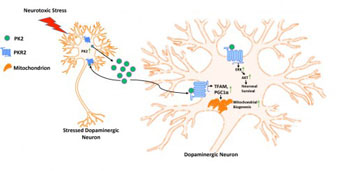Protein Helps Neurons Maintain Dopamine Production in Models of Parkinson's Disease
|
By LabMedica International staff writers Posted on 20 Oct 2016 |

Image: Diagram shows how the neuropeptide Prokineticin-2 (PK2) is rapidly induced during early stages of neurotoxic stress and secreted into extracellular spaces. PK2 is thought to act as a protective mechanism that helps neurons cope with Parkinson’s disease (Photo courtesy of Dr. Anumantha Kanthasamy, Iowa State University).
A team of neurodegenerative disease researchers has identified a protein that seems to help neurons in the brain maintain dopamine production.
Investigators at Iowa State University (Ames, USA) have been studying Prokineticin-2 (PK2), a recently discovered secreted protein that regulates important physiological functions including olfactory biogenesis and circadian rhythms in the central nervous system.
They reported in the October 5, 2016, online edition of the journal Nature Communications that although in mouse models PK2 expression was low in the nigral system of the brain, its receptors were constitutively expressed on nigrostriatal neurons, and that PK2 expression was highly induced in nigral dopaminergic neurons during early stages of degeneration in multiple mouse models of Parkinson’s disease (PD).
Functional studies demonstrated that PK2 promoted mitochondrial biogenesis and activated ERK (Extracellular signal-regulated kinase) and Akt (Protein kinase B) survival signaling pathways, thereby driving neuroprotection. Importantly, PK2 overexpression was protective, whereas PK2 receptor antagonism exacerbated dopaminergic degeneration in experimental PD.
PK2 signaling protected against oxidative stress, mitochondrial dysfunction, and dopaminergic degeneration. Blocking PK2 signaling using a PK2 receptor antagonist increased dopaminergic degeneration in a PD mouse model, while overexpression of PK2 by adeno-associated virus (AAV) gene delivery was neuroprotective. PK2 expression was also found to be elevated in the substantia nigra (SN) of PD patients, corroborating PK2’s clinical relevance in human PD.
“Of the thousands and thousands of factors we tracked in our experiments, why was this protein expressed so highly?” said senior author Dr. Anumantha Kanthasamy, professor of veterinary medicine at Iowa State University. “The neurons use PK2 to cope with stress. It is an in-built protective mechanism.”
Related Links:
Iowa State University
Investigators at Iowa State University (Ames, USA) have been studying Prokineticin-2 (PK2), a recently discovered secreted protein that regulates important physiological functions including olfactory biogenesis and circadian rhythms in the central nervous system.
They reported in the October 5, 2016, online edition of the journal Nature Communications that although in mouse models PK2 expression was low in the nigral system of the brain, its receptors were constitutively expressed on nigrostriatal neurons, and that PK2 expression was highly induced in nigral dopaminergic neurons during early stages of degeneration in multiple mouse models of Parkinson’s disease (PD).
Functional studies demonstrated that PK2 promoted mitochondrial biogenesis and activated ERK (Extracellular signal-regulated kinase) and Akt (Protein kinase B) survival signaling pathways, thereby driving neuroprotection. Importantly, PK2 overexpression was protective, whereas PK2 receptor antagonism exacerbated dopaminergic degeneration in experimental PD.
PK2 signaling protected against oxidative stress, mitochondrial dysfunction, and dopaminergic degeneration. Blocking PK2 signaling using a PK2 receptor antagonist increased dopaminergic degeneration in a PD mouse model, while overexpression of PK2 by adeno-associated virus (AAV) gene delivery was neuroprotective. PK2 expression was also found to be elevated in the substantia nigra (SN) of PD patients, corroborating PK2’s clinical relevance in human PD.
“Of the thousands and thousands of factors we tracked in our experiments, why was this protein expressed so highly?” said senior author Dr. Anumantha Kanthasamy, professor of veterinary medicine at Iowa State University. “The neurons use PK2 to cope with stress. It is an in-built protective mechanism.”
Related Links:
Iowa State University
Latest BioResearch News
- Genome Analysis Predicts Likelihood of Neurodisability in Oxygen-Deprived Newborns
- Gene Panel Predicts Disease Progession for Patients with B-cell Lymphoma
- New Method Simplifies Preparation of Tumor Genomic DNA Libraries
- New Tool Developed for Diagnosis of Chronic HBV Infection
- Panel of Genetic Loci Accurately Predicts Risk of Developing Gout
- Disrupted TGFB Signaling Linked to Increased Cancer-Related Bacteria
- Gene Fusion Protein Proposed as Prostate Cancer Biomarker
- NIV Test to Diagnose and Monitor Vascular Complications in Diabetes
- Semen Exosome MicroRNA Proves Biomarker for Prostate Cancer
- Genetic Loci Link Plasma Lipid Levels to CVD Risk
- Newly Identified Gene Network Aids in Early Diagnosis of Autism Spectrum Disorder
- Link Confirmed between Living in Poverty and Developing Diseases
- Genomic Study Identifies Kidney Disease Loci in Type I Diabetes Patients
- Liquid Biopsy More Effective for Analyzing Tumor Drug Resistance Mutations
- New Liquid Biopsy Assay Reveals Host-Pathogen Interactions
- Method Developed for Enriching Trophoblast Population in Samples
Channels
Clinical Chemistry
view channel
Noninvasive Blood-Glucose Monitoring to Replace Finger Pricks for Diabetics
People with diabetes often need to measure their blood glucose multiple times a day, most commonly through finger-prick blood tests or implanted sensors. These methods can be painful, inconvenient, and... Read more
POC Breath Diagnostic System to Detect Pneumonia-Causing Pathogens
Pseudomonas aeruginosa is a major cause of hospital-acquired and ventilator-associated pneumonia, particularly in lung transplant recipients and patients with structural lung disease. Its ability to form... Read moreMolecular Diagnostics
view channel
World's First NGS-Based Diagnostic Platform Fully Automates Sample-To-Result Process Within Single Device
Rapid point-of-need diagnostics are of critical need, especially in the areas of infectious disease and cancer testing and monitoring. Now, a direct-from-specimen platform that performs genomic analysis... Read more
Rapid Diagnostic Breakthrough Simultaneously Detects Resistance and Virulence in Klebsiella Pneumoniae
Antibiotic resistance is a steadily escalating threat to global healthcare, making common infections harder to treat and increasing the risk of severe complications. One of the most concerning pathogens... Read moreHematology
view channel
MRD Tests Could Predict Survival in Leukemia Patients
Acute myeloid leukemia is an aggressive blood cancer that disrupts normal blood cell production and often relapses even after intensive treatment. Clinicians currently lack early, reliable markers to predict... Read more
Platelet Activity Blood Test in Middle Age Could Identify Early Alzheimer’s Risk
Early detection of Alzheimer’s disease remains one of the biggest unmet needs in neurology, particularly because the biological changes underlying the disorder begin decades before memory symptoms appear.... Read more
Microvesicles Measurement Could Detect Vascular Injury in Sickle Cell Disease Patients
Assessing disease severity in sickle cell disease (SCD) remains challenging, especially when trying to predict hemolysis, vascular injury, and risk of complications such as vaso-occlusive crises.... Read more
ADLM’s New Coagulation Testing Guidance to Improve Care for Patients on Blood Thinners
Direct oral anticoagulants (DOACs) are one of the most common types of blood thinners. Patients take them to prevent a host of complications that could arise from blood clotting, including stroke, deep... Read moreImmunology
view channel
Blood Test Could Identify Colon Cancer Patients to Benefit from NSAIDs
Colon cancer remains a major cause of cancer-related illness, with many patients facing relapse even after surgery and chemotherapy. Up to 40% of people with stage III disease experience recurrence, highlighting... Read moreBlood Test Could Detect Adverse Immunotherapy Effects
Immune checkpoint inhibitors have transformed cancer treatment, but they can also trigger serious immune-related adverse events that damage healthy organs and may become life-threatening if not detected early.... Read moreMicrobiology
view channel
New UTI Diagnosis Method Delivers Antibiotic Resistance Results 24 Hours Earlier
Urinary tract infections affect around 152 million people every year, making them one of the most common bacterial infections worldwide. In routine medical practice, diagnosis often relies on rapid urine... Read more
Breakthroughs in Microbial Analysis to Enhance Disease Prediction
Microorganisms shape human health, ecosystems, and the planet’s climate, yet identifying them and understanding how they are related remains a major scientific challenge. Even with modern DNA sequencing,... Read morePathology
view channel
AI Tool Simultaneously Identifies Genetic Mutations and Disease Type
Interpreting genetic test results remains a major challenge in modern medicine, particularly for rare and complex diseases. While existing tools can indicate whether a genetic mutation is harmful, they... Read more
Rapid Low-Cost Tests Can Prevent Child Deaths from Contaminated Medicinal Syrups
Medicinal syrups contaminated with toxic chemicals have caused the deaths of hundreds of children worldwide, exposing a critical gap in how these products are tested before reaching patients.... Read more
Tumor Signals in Saliva and Blood Enable Non-Invasive Monitoring of Head and Neck Cancer
Head and neck cancers are among the most aggressive malignancies worldwide, with nearly 900,000 new cases diagnosed each year. Monitoring these cancers for recurrence or relapse typically relies on tissue... Read moreTechnology
view channel
Diagnostic Chip Monitors Chemotherapy Effectiveness for Brain Cancer
Glioblastoma is one of the most aggressive and fatal brain cancers, with most patients surviving less than two years after diagnosis. Treatment is particularly challenging because the tumor infiltrates... Read more
Machine Learning Models Diagnose ALS Earlier Through Blood Biomarkers
Amyotrophic lateral sclerosis (ALS) is a rapidly progressive neurodegenerative disease that is notoriously difficult to diagnose in its early stages. Early symptoms often overlap with other neurological... Read moreIndustry
view channel
BD and Penn Institute Collaborate to Advance Immunotherapy through Flow Cytometry
BD (Becton, Dickinson and Company, Franklin Lakes, NJ, USA) has entered into a strategic collaboration with the Institute for Immunology and Immune Health (I3H, Philadelphia, PA, USA) at the University... Read more
























